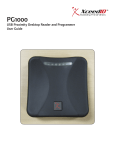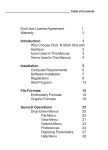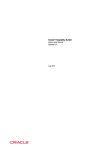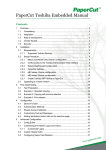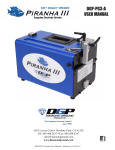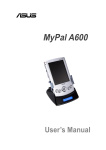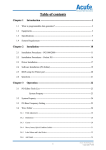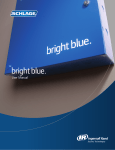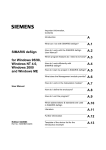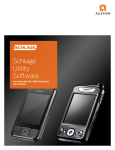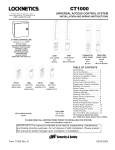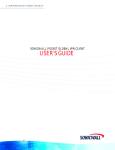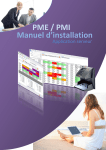Download SMS Express User Manual
Transcript
Security Management System Express Version 4 Software Manual Chapter 1 Ingersoll Rand Copyright Notice 1 Ingersoll Rand Copyright Notice © 2011 Ingersoll-Rand Company This documentation and the software/hardware described herein, is furnished under license and may be used only in accordance with the terms of such license. Information contained in this manual is subject to change without notice and does not represent any commitment on the part of Ingersoll Rand. Ingersoll Rand assumes no responsibility or liability for any errors or inaccuracies that may appear in this documentation. CONTACT INFORMATION Schlage Electronic Security Phone: 860-584-9158 Fax: 860-584-2136 www.schlage.com To contact a local Ingersoll Rand Security Technologies Consultant in your area go to: http://securitytechnologies.ingersollrand.com/ssc.asp i Contents Ingersoll Rand Copyright Notice 1 Introduction 5 Technical Support ................................................................................................................................................ 5 Locking Device Cross-Reference Table ............................................................................................................... 6 HHD Setup 7 Installing Microsoft® ActiveSync® or Windows Mobile Device ............................................................................ 7 Determining if ActiveSync is on the PC..................................................................................................... 7 Installing ActiveSync ................................................................................................................................. 9 Installing Windows Mobile Device Center ............................................................................................... 18 Connecting the HHD to the Desktop PC ................................................................................................. 20 Installing/Starting SMS Express 21 Installing SMS Express ...................................................................................................................................... 21 Starting SMS Express - Unlock Key ................................................................................................................... 25 Obtaining an Unlock Key ........................................................................................................................ 25 Entering the Unlock Key ......................................................................................................................... 28 Setting Up the Site/Quick Start 30 Creating a Facility .............................................................................................................................................. 30 Setting Credentials ............................................................................................................................................. 30 Setting the Facility Backup Location .................................................................................................................. 32 Setting the Synchronization Folder .................................................................................................................... 34 Adding System Operators .................................................................................................................................. 36 Assigning a Programming iButton to SPED Locks ............................................................................................. 38 Settings 39 Program Settings ............................................................................................................................................... 39 Credentials and Devices ......................................................................................................................... 39 Preferences ............................................................................................................................................ 43 ii Contents Audits ...................................................................................................................................................... 46 Programming .......................................................................................................................................... 48 Time Defaults .......................................................................................................................................... 51 Backup .................................................................................................................................................... 55 Operator Settings ............................................................................................................................................... 57 Manager Accounts .................................................................................................................................. 57 Programmer Accounts ............................................................................................................................ 57 Mag Card Template ........................................................................................................................................... 58 Edit the Mag Card Template ................................................................................................................... 59 Auto Card Replacement .......................................................................................................................... 60 Stock List 61 Stock List iButtons .............................................................................................................................................. 61 Add iButtons to the Stock List ................................................................................................................. 61 Find an iButton in the System ................................................................................................................. 61 Trash an iButton in the Stock List ........................................................................................................... 62 Mark an iButton as Lost .......................................................................................................................... 63 Stock List Cards ................................................................................................................................................. 63 Add Card to the Stock List ...................................................................................................................... 63 Find a Card in the System ...................................................................................................................... 64 Trash Cards in the Stock List .................................................................................................................. 65 Mark a Card as Lost................................................................................................................................ 65 Contents Monitoring iii 66 Start/Stop Monitoring ......................................................................................................................................... 66 Save/Print Event List .......................................................................................................................................... 68 Select Audit Events to Save ............................................................................................................................... 69 Audits 70 Viewing Audits.................................................................................................................................................... 70 Reports 70 View Saved Reports ........................................................................................................................................... 71 View a Report..................................................................................................................................................... 72 Delete a Report .................................................................................................................................................. 73 Using SMS Express 74 System Components .......................................................................................................................................... 74 Hardware Connection ........................................................................................................................................ 75 Starting SMS Express ........................................................................................................................................ 77 SmarTime (SMT)................................................................................................................................................ 78 User Time Zones .................................................................................................................................... 78 Door AutoUnlocks ................................................................................................................................... 80 Door Holidays ......................................................................................................................................... 82 Users .................................................................................................................................................................. 84 Adding a User ......................................................................................................................................... 84 Editing a User ......................................................................................................................................... 85 Deleting a User ....................................................................................................................................... 86 Doors ................................................................................................................................................................. 87 Add a Door .............................................................................................................................................. 87 Configure HandKey II Setup ................................................................................................................... 89 Edit a Door .............................................................................................................................................. 91 Copy SmarTime Functions from Door to Door ........................................................................................ 92 Delete a Door .......................................................................................................................................... 92 Credentials ......................................................................................................................................................... 93 Credential Types ..................................................................................................................................... 93 Credential Functions ............................................................................................................................... 94 Adding a Credential ................................................................................................................................ 94 iv Contents Using an Enrollment Reader ................................................................................................................... 97 Deleting a Credential ............................................................................................................................ 100 Assigning Access Rights .................................................................................................................................. 101 Generating Program Files ................................................................................................................................ 102 Generate Program Files for Offline Doors ............................................................................................. 102 Generate Program Files for Online Doors ............................................................................................. 103 Programming a Lock ........................................................................................................................................ 104 Selecting a System Programming Device ............................................................................................. 104 Programming a Lock Using a HHD. ...................................................................................................... 105 Updating Locks ..................................................................................................................................... 109 Appendix A: Upgrading from Previous Versions of SMS Express 112 Index 114 5 Introduction CHAPTER 1 Schlage Security Management System Express (SMS Express) is an access control management system that manages electronic access control devices. SMS Express manages and monitors online and offline devices. Each device has unique characteristics, which are all accessible through SMS Express. Technical Support For additional support and advice for Schlage SMS Express, contact technical support. U.S. Schlage Technical Support Phone: 877-671-7011 E-mail: [email protected] 6 SMSExpressUserManual Locking Device Cross-Reference Table The following table shows the cross-reference between installed Device, the Lock Type required to be specified on doors, and the Programming Device needed to transfer data to the device using UpLink if applicable. Device Lock Type Programming Device CM 5xxx Series CM/SPED Lock HHD plus CIP CM 993 Trim Series CM/SPED Lock HHD plus CIP CT Controller Series CM/SPED Lock HHD plus CIP SmartExit bars CM/SPED Lock HHD plus CIP SmartMagnets CM/SPED Lock HHD plus CIP HandKey II Handkey II Ethernet, serial SPED 5xxx Lock CM/SPED Lock HHD plus CIP SPED 9xxx Lock CM/SPED Lock HHD plus CIP SPED Deadbolt SPED Deadbolt HHD plus CIP AD-200 Series AD-200 HHD CO-200 Series CO-200 HHD 7 HHD Setup CHAPTER 2 Installing Microsoft® ActiveSync® or Windows Mobile Device If your computer is running Windows XP or earlier use Microsoft ActiveSync. If your computer is running Windows Vista or later, use Windows Mobile Device. NOTE: The following procedure is only applicable if a HHD (Hand Held Device) will be used to program locks at a facility, and must be performed before proceeding to Chapter 3, Installing/Starting SMS Express. You must set up the HHD before you install the SMS Express software. The HHD setup begins with the installation of Microsoft® ActiveSync® or Windows Mobile Device, which enables the HHD to communicate with the desktop PC. NOTE: If you plan to use a laptop computer instead of a HHD for programming locks, then the laptop computer must be the computer you use to maintain the database. Determining if ActiveSync is on the PC Installing ActiveSync on a computer that already has it installed can cause problems with the system. It is recommended that you check your computer for ActiveSync before installing. To see if ActiveSynch is on your computer: 1 Open the Control Panel. 8 SMSExpressUserManual 2 Open the Add or Remove Programs option. 3 Select Name from the Sort by drop down box. 4 Scroll down the list until you see Microsoft ActiveSync. If ActiveSync is listed then there is no need to install it on the computer. If Active Sync is NOT listed, then follow the instructions below to include it. Chapter 2 HHD Setup 9 Installing ActiveSync 1 Insert the CD into the disc drive. (You may want to check for a newer version on the Internet before proceeding.) 10 SMSExpressUserManual 2 Click Next. 3 Accept the license agreementand. Click Next. Chapter 2 HHD Setup 4 Enter your information. Click Next. 5 Click Next to begin installation. 11 12 SMSExpressUserManual 6 Click Install. Wait for the installation process to complete. 7 Click Finish. The HHD Setup Wizard will start automatically. Chapter 2 HHD Setup 8 Click Next. 9 De-select Favorites. 13 14 SMSExpressUserManual 10 Select Files. 11 Click OK. Chapter 2 HHD Setup 15 12 Click Settings. 13 Take note of the synchronization folder location. This information is necessary to set up SMSExpress to use the same synchronization folder as ActiveSync to transfer files properly. In this case the synchronization folder is C:\Documents and Settings\fcoolidg\My Docments\WM_FCoolidg My Documents\ 16 SMSExpressUserManual 14 Click OK. 15 Click Next. 16 Click Finish. The Setup Wizard will close. Chapter 2 HHD Setup 17 17 Open ActiveSync. 18 Select File > Connection Settings. NOTE: Make sure the connection settings are set correctly for the type of connection you are using. In this case, a USB connection will be used. 19 Click OK. 18 SMSExpressUserManual Installing Windows Mobile Device Center Windows Mobile Device Center (WMDC) is the successor to Microsoft Active Sync. WMDC is used with Windows Vista and Windows 7. Follow the instructions below to install WMDC. Finding the type of Operating System (OS) you have installed: You must first know which type of OS you have installed on your computer, the 32-bit type or the 64-bit type. To find out which type of OS you have installed: 1 On your computer, click the Start button. 2 In the Start Menu, click Control Panel. 3 In the Control Panel window, click System and Maintenance. 4 In the System and Maintenance window, click System. a) In the basic system information window that appears, your type of OS is indicated to the right of System type. It will either read, 32-bit Operating System or 64-bit Operating System. b) Make note of your OS type. This information will be needed in a later step. Downloading the WMDC installation file: You must download the WMDC installation file from the download section of Microsoft’s ® website. To download the WMDC installation file: 1 With your computer connected to the internet, open an internet browser. 2 Type the following into the browser’s address bar: microsoft.com/downloads 3 In the list of downloads: click on the following link if you have the 32-bit OS: Microsoft Windows Mobile Device Center (32-bit) or click on the following link if you have the 64-bit OS: Microsoft Windows Mobile Device Center (64-bit) Note: You might have to scroll down the page a little to see the 64-bit download. 4 Click the button labeled: Download. 5 In the File Download block that appears, click Save. 6 In the Save As block that appears, navigate to and click Desktop, then click Save. 7 If the Download Complete block is still open after download is finished, click Close. Installing the downloaded file: You must install the downloaded file into your computer system. To install the downloaded file: 1 On your computer’s desktop, double-click the downloaded file. Chapter 2 HHD Setup 2 19 When prompted, click to select one of the following options: Remind me Later Don’t Register Register 3 Connect the HHD to your computer. 4 In the Windows Mobile Member Center window, click Set up your device. 5 In the Set Up Windows Mobile Partnership window: a) You can either type in a meaningful name in the Device Name block or leave the default name as is. The choice is yours. b) Click to check the Create a shortcut on the Desktop to Windows Mobile Device Center check box. c) Click Set Up. d) When prompted, click to select the Files check box (you might have to scroll down some). e) Click Next. A WMDC Partnership has now been established. Finding the synchronization folder: The following steps will show you where the synchronization folder is located on your computer. To find the synchronization folder: 1 2 If the WMDC is not already open, do the following: a) Double-click the WMDC icon in the system tray. b) In the Synchronization window, double-click the icon labeled, Administrator’s PDA. The WMDC window appears. In the WMDC window, under the Mobile Device category: a) Click Change content sync settings. The WMDC window displays a list of items that can be changed. b) In the list of items, click to check the Files check box (If it isn’t already checked). c) Under Files, click Sync Settings. The following statement will appear: On this computer, synchronize the files in this folder: 3 A path to a synchronization folder is shown under that statement. Make note of the path to the sync. folder. This information will be needed in a later step. Changing the Path to the Synchronization Folder: 1 In the SMS Express main menu: a) Click Settings. b) In the drop-down menu, click Program Settings. A Program Settings window appears. 20 SMSExpressUserManual 2 In the Program Settings window: a) Click the Programming tab. b) Click to select the radio button for Locks will be programmed with a Pocket PC device. c) Click the Change Folder button associated with that field. The Select Path window will open. d) Navigate to and select the synchronization folder. e) Click OK. The selection window will close and the new path appears in the synchronization folder block of the SMS Express Program Settings window. f) Click Save. Connecting the HHD to the Desktop PC The HHD is connected to the desktop PC through a usb cable. Whenever you are not using the pocket PC away from the desktop PC, keep it connected to the AC adapter so it will stay fully charged. 1 Plug the HHD AC adapter into a power outlet. 2 Insert the AC adapter plug to the back of the HHD. 3 Attach the HHD's USB cable to the desktop PC. 4 Leave the Pocket PC connected to the power outlet until its battery is fully charged. Chapter 3 Installing/Starting SMS Express 21 Installing/Starting SMS Express CHAPTER 3 Installing SMS Express 1 Start the download by either: a) If you have the SMS Express CD, insert it in the CD-ROM drive of your computer. After a few moments, the installation process begins automatically. Follow the prompts on each window. b) If you have downloaded the installer, please double click the file you downloaded. 22 SMSExpressUserManual 2 The InstallShield Wizard will open to the Welcome screen. 3 Click Next. 4 Click on the I accept the terms in the license agreement button. Chapter 3 Installing/Starting SMS Express 5 Click Next. 6 Enter a User Name and Organization in the provided fields. 7 Click Next. 23 24 SMSExpressUserManual 8 Click Install. The installation process will begin. 9 When the process is complete the Completed screen will open. 10 Click Finish. SMS Express is now installed. Chapter 3 Installing/Starting SMS Express 25 Starting SMS Express - Unlock Key After completing the installation of SMS Express you will need to obtain and Unlock Key and enter it into SMS Express. Follow the instructions below. Obtaining an Unlock Key 1 Double-click on the desktop icon to start the SMS Express application. 2 Enter the default Username (manager). 3 Enter the default Password (123456). 4 Click Continue. The Unlock Key Hasn’t Been Entered window will open. 26 SMSExpressUserManual 5 Click Obtain Unlock Key. The Select Appropriate Option Below window will open. 6 Click the radio button for the I have already purchased this software... option to obtain an Unlock Key. 7 Click OK. The Obtain Unlock Key window will open. 8 Follow the instruction on the Obtain Unlock Key window to receive your Unlock Key. 9 Make note of the Unlock Key, you will need to enter it in the steps below. Chapter 3 Installing/Starting SMS Express 10 Click OK. The SMS Express Main Menu will open. 11 Exit SMS Express by selecting Facility>Exit. 12 Follow the steps below to enter the Unlock Key. 27 28 SMSExpressUserManual Entering the Unlock Key 1 To start the SMS Express application, double-click on the desktop icon. The log-in window will open. 2 Enter the default Username (manager). 3 Enter the default Password (123456). 4 Click Continue. The Unlock Key Hasn’t Been Entered window will open. Chapter 3 Installing/Starting SMS Express 5 Click Enter Unlock Key. The Software Registration Form will open. 6 Enter your Unlock Key. The default user name will be MANAGER in all uppercase letters. 29 NOTE: Your Machine ID and Unlock Key will be different than that shown in the above example. 7 Click Validate License. If successful the main SMS Express window will open. 8 Follow the steps below to verify the software. 30 SMSExpressUserManual Setting Up the Site/Quick Start CHAPTER 4 Creating a Facility A facility is an SMS Express database representing a physical or logical place for door location. SMS Express requires one facility, but can manage multiple ones. Facilities are independent and cannot share data. When you first install SMS Express a facility must be created. Follow the directions below to create a Facility. 1 In the Main Menu, select Facility > New Facility. The Creating a New Facility window will open. 2 Enter a name for the facility. Choose a name that describes your facility. A facility can be a building or an entire site. It can also be a floor, an annex, or a logical group, such as all entrances or all office doors. NOTE: The facility name cannot contain the following characters: # " / \ . < > : | * ? 3 Click OK. The name of your facility will appear in the lower left corner of the Main Menu. Setting Credentials Setting credentials for a facility consists of specifying the credential type that the facility will use, and setting any identifying parameters. 1 Select Settings > Program Settings in the Main Menu. Chapter 4 Setting Up the Site/Quick Start 31 2 In the Program Settings window, select the Credentials and Devices tab. 3 Change any of the default selections according to which credential technology your facility will be using by unselecting or selecting the appropriate credential types. The default selection when you create a new facility will use PIN/Codes, iButtons, and Card credentials. Note: If using AD or CO Series Locks the Using only 12 button keypads option must be checked. 4 If changes are made to the default settings click Save. DO NOT click Close at this time. 32 SMSExpressUserManual Setting the Facility Backup Location Always back up the facility and store the backup file in a safe location. Failure to back up the facility risks complete data loss. 1 In the Program Settings window, select the Backup tab. 2 Click the Prompt before backing up Facility check box if you want a reminder prompt to appear each time you close the facility. Otherwise, SMS Express backs up the facility automatically when you close the facility. Chapter 4 Setting Up the Site/Quick Start 3 33 To change the location of the backup folder, click Change Folder. The Select Path Window will open. The default location on a 32 Bit platform is C:\Program Files\Schlage Security Management System Express\ The default location on a 64 Bit platform is: C:\Progrma Files (x86)\Schlage Security Management System Express\ 4 Navigate to the new location in the Select Path window, click OK. Note: You should always copy your backed up databases to a network share, another hard drive, or external USB Drive. If your computer fails your databases are safe, secure, and recoverable. 5 Click Save. DO NOT click Close at this time. 34 SMSExpressUserManual Setting the Synchronization Folder Microsoft® ActiveSync® or Windows Mobile Device® created a synchronization folder on the desktop PC that the HHD uses to synchronize files with the desktop PC. SMS Express must know that location. The following procedure identifies the location of the synchronization folder so that SMS Express can use it. 1 In the Program Settings window, select the Programming tab. 2 Click Locks will be programmed with a Pocket PC device (the HHD). Chapter 4 Setting Up the Site/Quick Start 3 35 Click Change Folder. The Select Path window will open. The default location for a 32 Bit Platform is: C:\Program Files\Schlage Security Management System Express\Export The defualt location for a 64 Bit Platform is: C:\Program Files (x86)\Schlage Security Management System Express\Export 4 In the Set Path window, locate and select the folder that you recorded during the Installing Microsoft® ActiveSync® section. 5 Click OK. The Set Path window will close. 6 In the Program Settings window, click Save, then click Close. 36 SMSExpressUserManual Adding System Operators Adding system operators enables you and other staff members to have log in access to the SMS Express software. After you add at least one System Operator with all privileges, remember to delete the default Manager and Operator. 1 In the Main Menu, select Settings > Operator Settings. The Operators window will open. 2 Click Add at bottom of Manager pane to add a System Operator with all privileges (manager). The Add Manager window will open. NOTE: Managers have access to all SMS Express functionality. 3 In the Add Manager window: Enter the person’s name (4 to 20 characters). Chapter 4 Setting Up the Site/Quick Start 4 37 Enter a password (1 to 8 characters). Re-enter password. Click OK. The Add Manager window will close and the person is added to the Manager pane of the Operators window. Repeat these steps for any additional Managers. Click Add at bottom of Operator pane to add a System Operator with Door Programming privileges only (operator). The Add Programmer window will open. NOTE: Operators have restricted access; that is, they can only open a facility and program locks. 5 In the Add Programmer window: Enter the person’s name (4 to 20 characters). Enter a password (1 to 8 characters). Re-enter password. Click OK. The Add Programmer window will close and the person is added to the Operator pane of the Operators window. Repeat these steps for any additional Operators. 6 After you add all System Operators, delete the default Manager and Operator entries. 7 Click Close. 38 SMSExpressUserManual Assigning a Programming iButton to SPED Locks A programming iButton enables you to set a lock into programming mode. SPED locks direct from the factory do not initially accept the Programming iButton. You can assign a Proramming iButton to each SPED lock by the following steps. 1 At any SPED lock, enter the factory default programming code: 9 7 5 3 1 * The factory default code sets the SPED lock into programming mode. 2 When the flashing stops, enter the code: 7 * 3 Press a programming iButton to the SPED lock's iButton receptacle. The indicator light flashes green and red. 4 When the flashing stops, remove the iButton. The SPED lock will now accept the iButton for programming. The factory default code will no longer be valid. All SPED locks will accept a Black iButton as a programming key. You can only use a Red iButton to program a SPED Deadbolt. Chapter 5 Settings 39 Settings CHAPTER 5 You can customize certain aspects of system operation using the Settings menu. Program Settings You can change the program settings using the Program Settings menu. There are six (6) tabs in the Program Settings menu. Each tab is used to control a different aspect of the system. Credentials and Devices You can select which credentials and devices can be used with the system. By selecting only the credentials and devices that you currently use, screens and dialogs will be easier to navigate. NOTE: When you select or deselect credential and device types in this tab, the credential and device types that are available on other screens will be changed. Specifying Which Credentials and Devices are Available in the System 1 Click Settings > Program Settings. 40 SMSExpressUserManual 2 Click Credentials and Devices. 3 Click to select/deselect the desired credentials and devices. Note: Credentials and devices with check marks next to them will be enabled in the system. 4 If PIN credentials are enabled, specify whether all locks in your facility have 12-button keypads. See "How the Number of Buttons Affects PINs" for more information. 5 If you are using any SPED Deadbolts in your facility, and want to enable or disable the Lock & Leave feature by default, click to check or uncheck the check box for Enable Lock & Leave. Chapter 5 Settings 41 Note: If the Enable Lock & Leave check box is checked, all new SPED Deadbolt doors will have the Lock & Leave feature enabled. You can disable this feature later, per door. 6 If you have already created SPED Deadbolt doors in your facility and want to enable or disable the Lock & Leave feature on all of them, click Set all existing locks to default. 7 All SPED Deadbolt doors already in the facility will be changed to match the currently selected default. 8 Click Save. How the Number of Buttons Affects PINs Some locks have only six (6) buttons while others have twelve (12) buttons. If you are using locks with only six buttons in your facility, the number of PIN combinations is halved, since each button of a six button keypad has two numbers on it. Six-Button Keypad For example, if you are using any locks with six-button keypads in your facility, the PINs 13579 and 24680 are the same, because the same button combination is pressed to enter the two codes. Twelve-Button Keypad If you are using only locks with twelve-button keypads in your facility, each number has an individual key. Therefore, the PINs 13579 and 24680 are different, because a different button combination is pressed to enter the two codes. Setting the Default PIN Length 1 Click Settings > Program Settings. 2 Click Credentials and Devices. 42 SMSExpressUserManual 3 Select the default PIN length from the drop-down box. 4 Click Save. Chapter 5 Settings 43 Preferences The Preferences tab allows you to customize the look and functionality of some features of the system. 44 SMSExpressUserManual Change the Look of the Main Window There are two options for the look of the main window. The default look includes icons for Users, Doors, Access Rights, SmarTime (SMT), Generate Program Files and Tour with UpLink. You can choose to disable the icons, so that the listed functions are simple buttons, as shown below. 1 Click Settings > Program Settings. 2 Click Preferences. 3 Click to check or uncheck the Use Icon Buttons on Main Window check box. 4 Click Save. Chapter 5 Settings 45 Enable/Disable Stock List Note: See the Stock List section for more information. 1 Click Settings > Program Settings. 2 Click Preferences. 3 Click to check or uncheck the Enable Quick Loading of Stock Credentials check box. Note: When this box is unchecked, the Stock List menu will not be available in the menu bar. 4 Click Save. Enable/Disable Warning Messages 1 Click Settings > Program Settings. 2 Click Preferences. 46 SMSExpressUserManual 3 Click to check or uncheck the Show All Warning Messages check box. Note: When this box is unchecked, the warning messages will not be displayed. 4 Click Save. Audits In the Audits tab, you can change the maximum quantity of audits to be saved, purge audits and configure how purged audits are handled. Change the Maximum Quantity of Saved Audits 1 Click Settings > Program Settings. Chapter 5 Settings 2 Click Audits. 3 Enter the maximum quantity of audits to be saved in the box. 47 Note: This must be a number between 10 and 10,000,000. The default value is 10,000,000. 4 The amount of disk space required for the number you have entered will be automatically calculated. If this amount is unacceptable, enter a lower number. 5 Click Save. Save Purged Audits You can elect to save purged audits to a text file. If you elect to save purged audits, a text file with the current date as the file name will be saved in the OldAudits folder under the Schlage SMS Express installation folder (usually C:\Program Files\Schlage Security Management System Express\OldAudits\FacilityName -- for a 32 bit Platform or C:\Program Files (x86)\Schlage Security Management System Express\OldAudits\FacilityName -- for a 64 bit Platform). 1 Click Settings > Program Settings. 48 SMSExpressUserManual 2 Click Audits. 3 You can either save purged audits to a text file or elect not to save them. 4 Click the Do not save purged audits radio button to elect not to save purged audits. Click the Save purged audits... radio button to elect to save purged audits. Click Save. Purge Audits from Facility 1 Click Settings > Program Settings. 2 Click Audits. 3 Click Purge Now. 4 Click OK. 5 Click Save. Programming You can specify the programming method and location for programming files in the Programming tab. 1 Click Settings > Program Settings. Chapter 5 Settings 49 2 Click Programming. 3 You can choose from four programming methods. Click the radio button next to the method you want to use. Program locks using a SNAP programmer -- Select this option if using one of the Legacy SNAP programmers. Program locks using this computer. -- Select this option if using this computer. Program locks using a Pocket PC. -- Select this option if using the Legacy Pocket PC or the New HHD (Hand Held Device). The user will need to use the Change Folder option to select where program files will be saved (see instructions below) Program locks using another Windows computer. -- Select this option if using another Windows PC. The user will need to use the Change Folder option to select where program files will be saved (see instructions below) 4 If applicable, use the Change Folder option to select where program files will be saved (see instructions below). 5 Click Save. If using the Program locks using a Pocket PC option: 1 Click Change Folder. 2 Navigate to the folder being used for synchronization by the Pocket PC. 3 Click OK. 4 Click Save. If using the Program locks using another Windows computer option: 1 Click Change Folder. 2 Navigate to the folder being used for synchronization by the Pocket PC. 3 Click OK. 4 Click Save. Locating the Pocket PC Synchronization Folder 1 Make sure the Pocket PC you are using for programming is attached to your computer and is turned on. 50 SMSExpressUserManual 2 Launch Microsoft ActiveSync. 3 Double-click Files. Note: The Pocket PC or HHD must be connected for this icon to be visible. If you cannot locate this icon, consult the help file in Microsoft ActiveSync for information on connecting your PocketPC/HHD. 4 The File Synchronization Settings window will appear. The location of the synchronization folder is similar to the example shown below. 5 Note: You can copy and paste this path into the synchronization folder box on the programming tab, or use the Change Folder button to navigate to this folder. Chapter 5 Settings 51 Time Defaults You can specify time defaults in the Time Defaults tab. By changing these defaults, you can save time on entries in other areas of the system. Enable/Disable Adjust for Daylight Savings Time If this option is enabled (the box is checked), the system will automatically adjust for Daylight Savings Time. You should check this box unless the facility is located in an area that does not use Daylight Savings Time. 1 Click Settings > Program Settings. 2 Click Time Defaults. 52 SMSExpressUserManual 3 Click to check or uncheck the check box next to enable or disable Adjust for Daylight Savings Time. 4 Click Save. Enable/Disable First Person In by Default The First Person In feature is used in combination with AutoUnlocks. If the First Person In feature is enabled, the lock will remain locked until a user presents a credential to open the door. The lock will then stay unlocked until the end of the AutoUnlock period. This feature guarantees that at least one person is present when the door is open. Not all devices are capable of this feature. The First Person In by default option, when enabled, will make any lock that is capable of the First Person In feature to have it enabled by default. 1 Click Settings > Program Settings. 2 Click Time Defaults. 3 Click to check or uncheck the check box next to enable or disable First Person In by Default. 4 Click Save. Chapter 5 Settings 53 Enable/Disable Credential Default Activation and Expiration Date Setting these default dates does not mean that all credentials must abide by these rules. Both activation and expiration date can be changed in the user credential settings. The dates specified here will only be the default for new user records and will not affect existing user records in any way. 1 Click Settings > Program Settings. 2 Click Time Defaults. 3 Click to check or uncheck the check box next to Credential Default Activation Date to enable or disable. 4 If enabling the date, continue to step 4 below. If disabling the date, skip to step 5 below. The default activation date can be either a fixed date or a relative date. To set a fixed date, click the fixed date radio button and choose a date from the date drop-down box by clicking on the date. 54 SMSExpressUserManual 5 To set a relative date, click the relative date radio button and choose a number from the number dropdown box and a unit of time from the unit of time drop-down box. Click Save. Chapter 5 Settings 55 Backup Each time a facility is closed, the system will attempt to create a backup of the facility. If you want to have the option to cancel the backup, you can set the system to prompt you before creating the backup. This option is enabled by default. Note: You should always copy your backed up databases to a network share, another hard drive, or external USB Drive. If your computer fails your databases are safe, secure, and recoverable. Change Backup Folder Path 1 Click Settings > Program Settings. 56 SMSExpressUserManual 2 Click Backup. 3 Click <-Change Folder to browse for the folder in which you want to store backup files, or type the path to the folder in the box. 4 Click Save. Enable/Disable Prompt Before Backup 1 Click Settings > Program Settings. 2 Click Backup. 3 Click to check or uncheck the box next to Prompt before backing up Facility to enable or disable. 4 Click Save. Chapter 5 Settings 57 Operator Settings Operator Settings is used to add, delete and edit managers and operators. Managers are configured on the left side of the screen. Programmers are configured are the right side of the screen. Manager Accounts A manager has complete access to all features in the system. One manager account is included in the system by default. It has the following properties: Operator Name: Manager Password: 123456 Note: Change the password on this account immediately after logging in for the first time. Consider deleting this account after you have created another manager account to ensure system security. The number of manager accounts should be limited for security reasons. Programmer Accounts A programmer account has limited access to the system. Programmers are only allowed to generate program files and tour with uplink (if you are using your PC to tour your doors). One programmer account is included in the system by default. It has the following properties: Operator Name: Operator Password: 123456 58 SMSExpressUserManual Note: Change the password on this account immediately after logging in for the first time. Consider deleting this account after you have created another operator account to ensure system security. You should create a new account for each person who will have access to the system. When each person has an individual account, you can track the changes that were made by each system programmer. Mag Card Template A mag card that is used for access control is encoded with characters. Only 16 of these characters can be used by the system. Some of these characters may be set to be the same for all users within a facility and some of the characters are unique for each user. Only the unique characters are used for verification. The Mag Card Template is used to specify which characters should be used for verification. Example In the example above, the data in the Full Card Data (No Template applied) box shows that the card has been encoded with a facility code, which is separated from the rest of the data by an equal sign (=). The first ten (10) positions have been specified in the mag card template. The templated card data shows only the first ten (10) characters of the mag card data. The last five (5)digits do not need to be read by the system because they will be encoded to be the same for all cards in the facility. Using this technique, all cards from a particular facility can be easily identified by a system operator. The two numbers in the Update Data box show the numbers in positions nine (9) and ten (10). This position is specified in the 1st Lost Card Update Character box. The update data is used for auto card replacement. Chapter 5 Settings 59 Edit the Mag Card Template 1 Click Settings > Mag Card Template. 2 Click to select/deselect the positions to be used for the template. 3 Choose the 1st Lost Card Update Character from the drop-down list. Note: This position and the one immediately following it will be used for Auto Card Replacement (ACR). 4 5 You can test the mag cards to be used with the facility against the template. If using a serial reader or a lock to read the cards, double click the box below Full Card Date (No Template applied). Swipe the card within eight (8) seconds. If using a keyboard card reader, click Test and swipe the card. The data will be displayed in the three boxes below. 60 SMSExpressUserManual 6 Full Card Data shows all the data from the mag card. Templated Card Data shows the data within the template. Update Data shows the data used for lost card updates. Click Save. Auto Card Replacement Auto Card Replacement (ACR) is a feature used to issue a new card when a card is lost. Example In the example above, ten (10) characters have been specified in the template. The last two (2) characters of the template, characters nine (9) and ten (10) have been selected for the auto card replacement characters. This is indicated in the 1st Lost Card Update Character box. The data in the Update Data box shows 11. If the auto card replacement feature is used on this card, the number will be incremented to 12. Either one (1) or two (2) characters can be used for auto card replacement. To use only one character, choose the last character in the template for the 1st Lost Card Update Character. Note: Only certain characters are available for selection in the 1st Lost Card Update Character box. The mag card template can be adjusted until the character you want to select is available. Note: If only one (1) character is used, the number of replacement cards is limited to nine (9) cards. If two (2) characters are used, the number of replacement cards is limited to ninety-nine (99) cards. Chapter 5 Stock List 61 Stock List The Stock List feature is used to load iButtons and cards into the system in bulk. These credentials can then be selected and assigned to a user. Note: This menu is only available if Enable Quick Loading of Stock Credentials is selected in the Preferences menu. Only credentials that have been enabled in the Preferences menu will be available in the Stock List menu. Stock List iButtons From here the user can Add, Find, Trash and Mark as Lost any iButton credential in the system. Add iButtons to the Stock List 1 Click Stock List > iButtons. 2 Click Add. 3 The following box will appear. While this box is visible, touch the iButton to the iButton reader. 4 If you have more iButtons to enter, touch each iButton to the reader until all of them are entered 5 Press the Esc key on your keyboard after all the iButtons have been entered. Find an iButton in the System 1 Click Stock List > iButtons. 2 Click Find. 62 SMSExpressUserManual 3 When the box below appears, touch the iButton you want to find in the system to the iButton reader. 4 If the iButton is in use in the system, it will be displayed. If the iButton is assigned to a user, the following box will appear. Click OK to close the box. If the iButton is in the stock list, it will be highlighted in the stock list window. Trash an iButton in the Stock List If an iButton in the stock list stops functioning, the iButton can me marked as trashed. 1 Click Stock List > iButtons. 2 Click to select the number of the iButton you want to delete. 3 Click Trash. 4 Click Yes. Chapter 5 Stock List 63 Mark an iButton as Lost 1 Click Stock List > iButtons. 2 Click to select the number of the iButton you want to mark as lost. 3 Click Lost. 4 Click Yes. Stock List Cards From here the user can Add, Find, Trash and Mark as Lost any Card (mag or prox) credential in the system. Add Card to the Stock List Note: When adding cards to card stock, the RFIdea (pcSwipe and pcProx) enrollment reader will NOT work when adding cards to Card Stock. ONLY Serial connected enrollment reader or lock will work. 1 Click Stock List > Cards. 2 Click Add. 3 The following box will appear. While this box is visible, swipe the card. 64 SMSExpressUserManual 4 If you have more cards to enter, swipe the cards until all of them are entered. 5 Press the Esc key on your keyboard after all the cards have been entered. Find a Card in the System 1 Click Stock List > Cards. 2 Click Find. 3 When the box below appears, swipe the card you want to find in the system. 4 If the card is in use in the system, it will be displayed. If the card is assigned to a user, the following box will appear. Click OK to close the box. If the card is in the stock list, it will be highlighted in the stock list window. Chapter 5 Stock List Trash Cards in the Stock List If a Card in the stock list stops functioning, the Card can me marked as trashed. 1 Click Stock List > Cards. 2 Click to select the number of the card you want to delete. 3 Click Trash. 4 Click Yes. Mark a Card as Lost 1 Click Stock List > Cards. 2 Click to select the number of the card you want to mark as lost. 3 Click Lost. 4 Click Yes. 65 66 SMSExpressUserManual Monitoring Schlage Security Management System Express can monitor all activities for the online devices. These devices are HandKey readers that are connected through a serial connection or to an Ethernet network. Note: This option will only appear if you have the Handkey option checked under Program Settings. See the Program Settings section for details. Start/Stop Monitoring To Start Monitoring: 1 Click Monitoring > Start Monitoring. 2 The Monitor Running will be displayed in the bottom right of the screen and the monitoring screen will appear. Any new events will be displayed in the monitoring screen. 3 Click on the title of any column to sort the list by that column. Click the same column again to change the sort order. Chapter 5 Monitoring To Stop Monitoring: 1 Click Monitoring > Stop Monitoring. 2 Monitoring Stopped will be displayed in the bottom right of the main window. 67 68 SMSExpressUserManual Save/Print Event List To Save the Event List: 1 In the monitoring screen, click File > Save As. 2 Browse to the location on your computer to which you want to save the file. 3 Enter a name for the file into the File Name box. 4 Click Save. 5 The file can be viewed using any text editing software. Navigate to the location on your computer to which you save the file and double-click to open the file. Below is an example of a saved event list. To Print the Event List: 1 In the monitoring screen, click File > Print. 2 Click to select the printer to which you want to print from the list of installed printers. 3 Click Print. Chapter 5 Monitoring 69 Select Audit Events to Save Select Audit Events to Save is used to select the events that will be saved in the audit for each online door. See the Audits section for more information. 1 2 Click Monitoring > Select Audit Events to Save. Click to check/uncheck the check boxes next to the events you want to save in the audit report. Click Default to automatically select the default set of events. 3 Click Save. 4 Click Close. 70 SMSExpressUserManual Audits An audit is a list of events for one or more doors. An audit event is any event that occurs at a door. Audit events are recorded in an audit. An audit trail is a list of audit events. An audit trail can be retrieved from a locking device that is equipped with the audit trail feature or the SmarTime feature. Audits can be viewed using the audit viewer in SMS Express. Viewing Audits To View an Audit: 1 Click Audits. 2 Then select the viewing parameter. Audits can be viewed by: 3 Door and Date -- The report viewer will be displayed with the audit by door and date already loaded. Door and User -- The report viewer will be displayed with the audit by door and user already loaded. User and Date -- The report viewer will be displayed with the audit by user and date already loaded. Date -- The report viewer will be displayed with the audit by date already loaded. The report viewer will open with the selected criteria. See the Reports section for details. Reports An audit trail from any lock in the system can be viewed using the report viewer. When a report is viewed, a new file is created from the most recent audit trail that exists in the system. Chapter 5 Reports View Saved Reports Reports that have been previously created can be viewed using the report viewer. 1 Click Reports > View Saved Reports. 2 Reports can be found in three ways: Search by File Name a) Click the search button. b) Click File Name. c) Click + to expand the folder of the first letter of the file name you want to view. d) Click the name of the file you want to view. Search by Creation Date a) Click the search button. 71 72 SMSExpressUserManual b) Click Creation Date. c) Click + to expand the folder for the year you want to view. d) Click the date of the file you want to view. Browse for a Saved File Click the open file button. Browse for a file that has been saved on your system. Click to select the file and click Open. View a Report 1 Click Reports. 2 Choose one of the following: Chapter 5 Reports User > Name Phone Address Door Holidays by Door AutoUnlocks by Door Access by User Access by Door Issued Credential History 73 These reports can be sorted and printed to meet your requirements. Delete a Report Note: Reports should not be deleted. Report files are regenerated after being deleted, so no disk space is saved by deleting report files. Some problems, such as 'file not found' errors, may be encountered if report files are deleted. 1 Click Reports > View Saved Reports. 2 Click the search button. 3 Click File Name. 4 Click + to expand the folder of the first letter of the file name you want to delete. 5 Click the name of the file you want to delete. 6 Click the trash can button. 7 Click Yes. 74 SMSExpressUserManual Using SMS Express CHAPTER 6 System Components Before you start using the SMS Express Software, take a moment to get to know the components that you will be handling. AD 200 Series Locks The AD-200 Series Locks are battery powered offline locks that can use various credentials (PIN, Prox, Mag stripe, Card + PIN). The AD-200 locks are modular and read different credentials with additional hardware addons. CO-200 Series Locks The CO-200 Series locks are battery powered offline locks that can use various credentials. SPED Deadbolt The battery-powered SPED Deadbolt is an electronically programmable deadbolt lock. It is programmed to accept iButtons. When an iButton is presented to the SPED Deadbolt, the lock reads the electronic signature of the iButton and if the lock has been programmed to accept that signature, the lock will operate. SPED 5000 and 9000 The battery-powered King Cobra is an electronically programmable lockset that can store PIN codes and iButtons. CM993 The CM993 is a computer managed retrofit trim and interfaces with Von Duprin 98 & 99 Series Exit Devices. Models of CM993 are available that will accommodate a variety of credentials, i.e., mag stripe card, HID prox card, iButton and keypad. CT1000 Controller The CT1000 Controller is an offline, hardwired, universal controller that supports 1000 users and 1000 audit events The CT1000 supports iButtons, mag stripe cards, PIN codes and HID prox cards. HHD Using the HHD you can transfer information to and from the locks without having to return multiple times to the desktop PC. When connected together, the HHD and the desktop PC transfer new or updated programming and audit trail information between each other. Will connect to AD and CO series locks with the included USB cable. Can connect to other locks with the CIP add on. Works with all credentials. SMS Express Software SMS Express software is an easy-to-use system that provides access control and key management for both multi- Chapter 6 Using SMS Express 75 family residences and commercial facilities. Backup Facility Files Always back up your SMS Express facility files. Back up the files to diskette, CD, network or flash drive. The backup facility files are a safeguard in case theft, fire, computer virus, or other disaster should strike the desktop PC that houses your database. User Credentials User Credentials lets you lock or unlock a variety of locks which have been programmed to accept the credential. Red iButtons are for programming. Black iButtons are for user access. All SPED locks, except SPED Deadbolts, will also accept a Black iButton as a programming key. You can only use a Red iButton to program a SPED Deadbolt. HH-USB Cable This cable comes with the HHD. It is used to connect the HHD to a desktop PC and to USB enabled locks (CO and AD series). HH-SERIAL Cable This is an additional cable that can be purchased separately from the HHD that connects the HHD to the CIP. Computer Interface Peripheral (CIP) The CIP is used to connect to non-USB enabled locks. Use the CIP to transfer data between the non-USB enable lock and the HHD. Hardware Connection Prior to making facility changes in SMS or programming a lock, your hardware must be connected properly. Connect hardware as shown below. From PC to HHD Use the standard HHD USB cable (HH-USB) to connect the HHD to the PC. 76 SMSExpressUserManual From HHD to USB enabled Lock (AD or CO series) Use the standard HHD USB cable (HH-USB) to connect the HHD to USB enabled lock. From HHD to non-USB enabled Lock Use the HHD Serial cable (HH-SERIAL) to connect the HHD to the CIP then connect the CIP to the Lock. NOTE: Regardless of lock model, smaller circle on CIP always plugs into smaller circle on iButton receptacle of lock being programmed. Chapter 6 Using SMS Express 77 Starting SMS Express Starting SMS Express requires an Operator Name and Password, usually obtained from the Facility Manager. 1 Double-click the SMS Express icon on the desktop. 2 Type your operator name and password in the corresponding fields, then click OK. The system displays the SMS Express Main Window: 78 SMSExpressUserManual You are now ready to use the SMS Express software. NOTE: The Facility name is in the lower left corner. If this is not the facility for which you need to make changes,go to Facility>Open Facility and choose the correct Facility. SmarTime (SMT) SmarTime is a collection of time-based functions that allow locks to behave differently based on time restrictions. SmarTime functions include User Time Zones, Door AutoUnlocks and Door Holidays. User Time Zones A user time zone is a defined period of time that is assigned to an access right in order to grant access to users. This is different from a world time zone such as Mountain Standard Time. The 24Hr X 7 Days (Default) user time zone is created, by default, in every facility. This user time zone cannot be deleted or edited. It is used by every lock that supports user time zones to give 24 X 7 access. Any time an access right is assigned to a door that supports user time zones, this user time zone is used unless another user time zone is assigned. Add a User Time Zone 1 Click SmarTime (SMT). 2 Click New. 3 Enter the name in the Name box. 4 A name is required and must be between one (1) and thirty-two (32) characters long. The name cannot contain the tab character or the pound (#) sign. Set the Start Time and the End Time. The time boxes are divided into four parts: hour, minute, second and day part. To enter the time, click on the time part you want to change. Then either type the value or use the arrow buttons on the right of the time box to increase or decrease the time. 5 Check the box below each day of the week for which the user time zone will be in effect. 6 Click Save. Chapter 6 Using SMS Express 79 Edit a User Time Zone 1 Click SmarTime (SMT). 2 Click to highlight the name of the user time zone you want to edit. 3 Click Edit. 4 Enter the name in the Name box. 5 A name is required and must be between one (1) and thirty-two (32) characters long. The name cannot contain the tab character or the pound (#) sign. Set the Start Time and the End Time. The time boxes are divided into four parts: hour, minute, second and day part. To enter the time, click on the time part you want to change. Then either type the value or use the arrow buttons on the right of the time box to increase or decrease the time. 6 Check the box below each day of the week for which the user time zone will be in effect. 7 Click Save. NOTE: The user time zone will not be changed on the door until the door is reprogrammed. Delete a User TimeZone NOTE: The 24Hr X 7 Days (Default) user time zone cannot be deleted. 1 Click SmarTime (SMT). 2 Click to highlight the name of the user time zone you want to delete. 80 SMSExpressUserManual 3 Click Delete. 4 Click Yes. The user time zone will still be active on the door until the door is reprogrammed. Door AutoUnlocks An AutoUnlock is a defined time period during which a lock is unlocked. At the end of the AutoUnlock time period, the lock will automatically relock. No audit events of legal access are logged during an AutoUnlock time period. Only the start and end of the AutoUnlock will be logged. AutoUnlocks are overridden by holidays. Up to sixteen (16) door AutoUnlocks can be added to a facility. Not all locks support AutoUnlocks. Secured Mode AutoUnlock If an AutoUnlock has the same start and end time, the lock will be set to secure (locked) mode at that time. Using this technique, you can make sure that a lock is locked from a specific time of day until it is unlocked by either a user, another AutoUnlock or a holiday. Add a Door AutoUnlock 1 Click SmarTime (SMT). 2 Click Door AutoUnlocks. 3 Click New. 4 Enter the name in the Name box. 5 A name is required and must be between one (1) and thirty-two (32) characters long. The name cannot contain the tab character or the pound (#) sign. Set the Start Time and the End Time. The time boxes are divided into four parts: hour, minute, second and day part. To enter the time, click on the time part you want to change. Then either type the value or use the arrow buttons on the right of the time box to increase or decrease the time. 6 Check the box below each day of the week for which the user time zone will be in effect. 7 Click Save. Chapter 6 Using SMS Express 8 81 If you have entered the same time for the start and end times, a window will appear to confirm the creation of a secured mode AutoUnlock. If you intended to create this kind of AutoUnlock, click OK. If you did not intend to create this kind of AutoUnlock, click Cancel and go back to step 5. Edit a Door AutoUnlock 1 Click SmarTime (SMT). 2 Click Door AutoUnlocks. 3 Click to highlight the name of the door AutoUnlock you want to edit. 4 Click Edit. 5 Enter the name in the Name box. 6 A name is required and must be between one (1) and thirty-two (32) characters long. The name cannot contain the tab character or the pound (#) sign. Set the Start Time and the End Time. The time boxes are divided into four parts: hour, minute, second and day part. To enter the time, click on the time part you want to change. Then either type the value or use the arrow buttons on the right of the time box to increase or decrease the time. If the start time and the end time are the same, the lock will be set to secured mode (locked) at that time. 7 Check the box below each day of the week for which the user time zone will be in effect. 8 Click Save. 9 If you have entered the same time for the start and end times, a window will appear to confirm the creation of a secured mode AutoUnlock. If you intended to create this kind of AutoUnlock, click OK. If you did not intend to create this kind of AutoUnlock, click Cancel and go back to step 5. NOTE: The AutoUnlock will not be changed on the door until the door is reprogrammed. Delete a Door AutoUnlock 1 Click SmarTime (SMT). 2 Click Door AutoUnlocks. 82 SMSExpressUserManual 3 Click to highlight the name of the door AutoUnlock you want to delete. 4 Click Delete. 5 Click Yes. NOTE: The AutoUnlock will still be active on the door until the door is reprogrammed. Door Holidays A holiday is a defined time period during which a door remains in a secure, secured lockout or passage state. A holiday can span over an unlimited amount of time and is non-repeatable. Holidays override AutoUnlocks. Up to sixteen (16) door holidays can be added to a facility. Not all locks support holidays Add a Door Holiday 1 Click SmarTime (SMT). 2 Click Door Holidays. 3 Click New. 4 Enter the name for the door holiday. 5 6 A name is required and must be between one (1) and thirty-two (32) characters long. The name cannot contain the tab character or the pound (#) sign. Set the Start Time and the End Time. The date boxes are divided into three parts: month, day and year. To enter the date, click on the date part you want to change and type the value. The date can also be chosen by clicking the down arrow on the right side of the date box. A calendar pop-up box will appear. Change the month by clicking the left or right arrow at the top of the box. Choose the date by clicking on the number in the calendar. The time boxes are divided into four parts: hour, minute, second and day part. To enter the time, click on the time part you want to change. Then either type the value or use the arrow buttons on the right of the time box to increase or decrease the time. Choose the function for the holiday by clicking the radio button next to the desired function. Only one function for holiday can be chosen. Secure - Secure is a mode that sets the door to the locked state. A user who has access rights and a valid credential can unlock a door set to secure mode. The door will re-lock after the specified relock time. Chapter 6 Using SMS Express 83 Secured Lockout - Secured lockout is a mode that sets the door to the locked state and locks out all credentials except pass through credentials. A user who has access rights and a valid pass through credential can unlock a door set to secured lockout mode. The door will re-lock after the specified relock time. Passage - Passage is a mode that sets the door to the unlocked state. Any person can open a door with a lock set to passage mode. The door can be locked, and will remain locked, with a toggle credential. 7 Click Save. Edit a Door Holiday 1 Click SmarTime (SMT). 2 Click Door Holidays. 3 Click to highlight the name of the door holiday you want to edit. 4 Click Edit. 5 Edit the name in the Name box. 6 7 A name is required and must be between one (1) and thirty-two (32) characters long. The name cannot contain the tab character or the pound (#) sign. Set the Start Time and the End Time. The date boxes are divided into three parts: month, day and year. To enter the date, click on the date part you want to change and type the value. The date can also be chosen by clicking the down arrow on the right side of the date box. A calendar pop-up box will appear. Change the month by clicking the left or right arrow at the top of the box. Choose the date by clicking on the number in the calendar. The time boxes are divided into four parts: hour, minute, second and day part. To enter the time, click on the time part you want to change. Then either type the value or use the arrow buttons on the right of the time box to increase or decrease the time. Choose the function for the holiday by clicking the radio button next to the desired function. Only one function for holiday can be chosen. Secure - Secure is a mode that sets the door to the locked state. A user who has access rights and a valid credential can unlock a door set to secure mode. The door will re-lock after the specified relock time. 84 SMSExpressUserManual Secured Lockout - Secured lockout is a mode that sets the door to the locked state and locks out all credentials except pass through credentials. A user who has access rights and a valid pass through credential can unlock a door set to secured lockout mode. The door will re-lock after the specified relock time. Passage - Passage is a mode that sets the door to the unlocked state. Any person can open a door with a lock set to passage mode. The door can be locked, and will remain locked, with a toggle credential. 8 Click Save. NOTE: The door holiday will not be changed on the door until the door is reprogrammed. Delete a Door Holiday 1 Click SmarTime (SMT). 2 Click Door Holidays. 3 Click to highlight the name of the door holiday you want to edit. 4 Click Delete. 5 Click Yes. NOTE: The door holiday will not be changed on the door until the door is reprogrammed. Users Adding a User Create a user record so you can assign a credential to a new user. A user is anyone assigned a credential to operate specific doors locks. 1 Click Users in the Main Window: Chapter 6 Using SMS Express 85 2 Click New at the bottom of the left pane: 3 Enter up to 16 characters each for the Last Name and First Name fields (the other fields are optional): Assign users to groups by entering a group name in the Group field. It’s easier to manage multiple users when they’re assigned to a group. If multiple groups are currently available in the Group dropdown list, make sure all new users are assigned to the proper group. Speak with your site administrator if you are unsure what to select. 4 Click Save to save the new record. 5 Click Close to return to the Main Menu. Editing a User Keep user information up to date by editing the user entry. When a resident moves out and returns all credentials, edit the user entry so that it shows information for the new resident. 1 Click Users in the Main Window. 86 SMSExpressUserManual 2 Click Edit at the bottom of the left pane. 3 Modify values of any fields. 4 Click Save to save the new record. 5 Click Close to return to the Main Menu. Deleting a User Delete a user to remove old records. 1 Click Users in the Main Window 2 Select one user in the left pane and click Delete: Chapter 6 Using SMS Express 87 NOTE: When you delete a user assigned to a credential, you will be prompted to delete the credential (see the credential section for details). 3 Click Yes to confirm the deletion of the user. 4 Click Close to return to the Main Menu. Doors Door is the generic term for any opening that can be secured with a locking device. A door can be a regular internal or external entrance or exit, a sliding door, a cabinet etc. "Door" is also used as a synonym for "locking device" or "lock". The Doors Window The Doors window is used to add, edit and delete doors. It is also used to assign and remove AutoUnlocks and Holidays, and to copy SmarTime functions from one door to another. Open the Doors Window Click the Doors button on the main menu to open the users window. Sort Doors Click any heading to sort doors by that heading. View Door Information Click on any door title to view the information for that door. Add a Door 1 Click Doors. 2 Click New. 3 Enter the name for the door in the Name box. 4 The door name cannot contain the tab or the pound (#) character. If you are using a SNAP programmer to program the doors in your facility, the name of the door must be between one (1) and eight (8) characters. 5 Enter any (optional) notes in the Notes box. 6 Select the type of door (lock) from the Type box. Follow the directions below for the chosen lock type: 88 SMSExpressUserManual CO-200/AD-200 1 Click the Use First Person In For AutoUnlock Schedules check box to enable/disable the Use First Person In feature. 2 Click to select/deselect the check box(es) next to each credential type that can be used on this lock. 3 Assign AutoUnlocks to the door, if desired. 4 Credentials available in this section depend on settings selected in the Credentials and Devices section of Program Settings. AutoUnlocks can be assigned to a door at any time. Assign holidays to the door, if desired. Holidays can be assigned to a door at any time. CM/SPED Lock 1 Click the Use First Person In For AutoUnlock Schedules check box to enable/disable the Use First Person In feature. 2 Click to select/deselect the check box(es) next to each credential type that can be used on this lock. 3 Assign AutoUnlocks to the door, if desired. 4 Credentials available in this section depend on settings selected in the Credentials and Devices section of Program Settings. AutoUnlocks can be assigned to a door at any time. Assign holidays to the door, if desired. Holidays can be assigned to a door at any time. HandKey II 1 Enter the reader address into the Reader Address box. 2 Select the connection type from the Connection Type box. 3 Check with your system administrator or see the HandKey II documentation for information on determining the connection type. Enter the IP address into the TCP/IP Address box or select the serial port from the Serial Port dropdown box 4 The address must be between 0 and 254. The address 170 is reserved and cannot be used. See the HandKey II documentation for information on locating the reader address. Check with your system administrator or see the HandKey II documentation for information on determining the IP address or serial port. Click Test Connection. a) If the Connection Successful box appears, click OK. All options were configured correctly and the reader and the system are communicating properly. b) If the No Reader Found box appears, click OK and go back to step 6 and check all options. The reader cannot be located using the settings provided. 5 Click Configure Setup to configure the reader setup. 6 Assign AutoUnlocks to the door, if desired. AutoUnlocks can be assigned to a door at any time. Chapter 6 Using SMS Express 7 89 Assign holidays to the door, if desired. Holidays can be assigned to a door at any time. Mechanical The Mechanical Lock Properties information is completely optional. The Schlage SMS Software does not utilize this information in anyway. This screen is used to record the mechanical key management information for your facility for those locks/doors that are not controlled electronically or to record the mechanical key override information of electronic lock with mechanical key override capability. To complete this information, you will need to work directly with your facility locksmith. If you are unsure whether you should enter mechanical key information into Schlage SMS software, contact technical support. 1 To add lock properties, click Properties. SPED Deadbolt Lock 1 Click to select/deselect the Enable Lock & Leave check box to enable/disable the Lock & Leave feature. The Lock & Leave Feature is a feature that applies only to SPED Deadbolts. When Lock and Leave is enabled, the deadbolt can be re-locked from the outside of the door for a short period of time. By default, the Lock and Leave feature is disabled. After the Device type has been chosen and set up: 1 Click Save. 2 Click Close to return to the main window. Configure HandKey II Setup 1 Click Doors. 2 Click to highlight the name of the HandKey II door you want to edit in the list and then click Edit. 3 Click Configure Setup. 4 Choose one of the following: 5 Get Current Settings from the Reader 6 7 a) Click Get Settings From Reader. b) The current settings will be displayed in each of the fields in the window. c) Click OK. d) Click Close. Change Settings in the Reader a) Make changes to the desired fields. b) Click Update Reader. c) Click OK. d) Click Close. Click Save. 90 SMSExpressUserManual 8 Click Close. Hand Reader Setup Data Reference Info Reader Address - Displays the address of the current reader as reference information. The entry in Reader Address cannot be edited in this screen. Operating Settings Access Retries Before Lockout - Sets the number of failed identification attempts allowed until a user is locked out of a reader. The lockout is removed after a different user successfully accesses the door. The range is 1 - 250 and the default is 3. Default Reject Threshold - Sets the level required for a hand template to match with the stored template. A read scoring below this level is considered a good read; anything above is rejected. Setting the level low results in a secure system, but may increase the false rejection rate, which reduces the convenience of use. This default level is used when the individual reject threshold in the user record is set to zero, otherwise the individual reject threshold overrides the default setting regardless if it is higher or lower. The range is 30 - 250 and the default is 100. Output Mode - Lock Output Mode has two options: Lock sets the relay output to simply open or close. Card sets the relay output to send out a number sequence that operates a Wiegand Control Module. Chapter 6 Using SMS Express 91 AUX Relay Time in Seconds - Number of seconds for which the AUX output contact changes its state after an event caused it to be activated. The range is 0 - 2000 and the default is 5. Re-lock Time in Seconds - Number of seconds for which the door will stay unlocked after a successful identification. The range is 0 - 2000 and the default is 5. Door Shunt in Seconds Number of seconds between the end of the relock delay time and the beginning of a "Door Propped Open" alarm. The range is 0 - 20000 and the default is 10. Feedback Beeper - When checked, the beeper will sound each time a button is pressed on the reader. Default is checked. 12 Hour Display - When checked, the time on the reader is displayed in the 12 hour AM / PM format. The default is unchecked. Valid Access Clears AUX - When checked, a successful user identification will reset the AUX output. This can be used, for example, to cancel a local alarm. The default is checked. Print Valid Access Attempt - When checked, the reader will print the "Valid Access" event message on a printer that has been connected to the reader. This option will only function when a printer is connected to the reader. The default is checked. Display System Status - When checked, the reader status will be displayed instead of the time and date. This can be used as a troubleshooting technique. The default is unchecked. Reader Menu Passwords Security - Security menu password. Range is: 0 - 9999999999 Default is: 5 Enrollment - Enrollment menu password. Range is: 0 - 9999999999 Default is: 4 Management - Management menu password. Range is: 0 - 9999999999 Default is: 3 Setup - Setup menu password. Range is: 0 - 9999999999 Default is: 2 Service - Service menu password. Range is: 0 - 9999999999 Default is: 1 AUX Output On Door Alarm - When checked, the AUX Output will be activated when a door alarm occurs. AUX In - When checked, the AUX Output will be activated when a signal change occurs at the AUX Input. Invalid Access - When checked, the AUX Output will be activated when a when an invalid access event occurs. Tamper - When checked, the AUX Output will be activated when a when the tamper switch is activated. Power Failure - When checked, the AUX Output will be activated when a when a power failure occurs. Edit a Door 1 Click Doors. 2 Click to highlight the name of the door you want to edit. 3 Click Edit. 4 Make any necessary changes. Use the information in the Add a Door section as a reference. 5 Click Save. 92 SMSExpressUserManual Copy SmarTime Functions from Door to Door A set of SmarTime functions (AutoUnlocks and Holidays) can be copied from one door to another door, or to many doors. This is useful if you want all (or a large number of) the locks in your facility to have the same AutoUnlocks and Holidays. There are several things to remember when copying SmarTime functions: SmarTime functions can only be copied to those doors that are capable of the selected SmarTime functions. If a door cannot manage the full number of the SmarTime functions that are being copied, then only the first items in the list will be copied. Holidays that are set as "Passage" or "Secured" will not be copied to doors that can only manage Holidays that are set to "Secured Lockout". If the door designated as the copy source has Holidays assigned that are set to "Secured Lockout", then only these Holidays will be copied. NOTE: When SmarTime functions are copied from one door to another, all previously assigned SmarTime functions will be lost. 1 Click Doors. 2 Click to highlight the name of the door from which you want to copy SmarTime functions. 3 Click Copy SMT. 4 Click to select/deselect the check boxes next to the type of SmarTime functions you want to copy. 5 Click to highlight the name(s) of the door(s) to which you want to copy the SmarTime functions. 6 Multiple selections can be made by holding down the Shift or Ctrl key on your keyboard. Click Copy & Close. Delete a Door 1 Click Doors. 2 Click to highlight the name of the door you want to delete. Multiple doors can be selected by holding down the Shift or Ctrl key on your keyboard. 3 Click Delete. Chapter 6 Using SMS Express 4 93 Click Yes. NOTE: Users will continue to have access to doors that have been deleted from the system until the lock is physically removed from the door. Credentials Credentials are used to gain access to a door. Credentials can be PINs, Card (Mag or Prox), iButton or an RSI Hand reader. Credential Types PIN This is the only logical credential available. A PIN is simply a sequence of numbers and does not require a device. A PIN is easy to create, has no expense associated with it, but is not very secure. PIN is an acronym for Personal Identification Number. iButton An iButton is a microchip in a battery case. Each chip has a unique serial number that is used for identification. iButtons are very durable, moderately priced and secure. iButtons can be combined with PINs when the associated hardware provides this feature. Card (Mag or Prox) Mag Card Mag Card is a short term for magnetic stripe card. Mag Cards are low cost and secure, but are susceptible to magnetic fields. Prox Card Prox Card is short for Proximity Card. Prox cards are also available as fobs. Prox cards are more expensive than mag cards but usually perform better, are not susceptible to magnetic fields and are just as secure. RSI Hand An RSI Hand is the only biometric credential available. Hands are always combined with a PIN. The PIN can be encoded on a card (mag or prox). Hands have the highest available security level at no incremental cost. 94 SMSExpressUserManual Credential Functions Normal A normal credential opens a door for a specified time. The time span is defined by the relock delay. The normal function works on all devices. Toggle A toggle credential opens a door and leaves it open until it is closed again by a toggle credential. It toggles a door between locked and unlocked. Freeze A freeze credential disables the credential reader. After a freeze credential has been used on a lock, only a pass through credential will operate the lock. Present a freeze credential to return the lock to an operational state. One Time Use A one time use credential opens a door only once with the normal function. Once a one time use credential has been used on a door, it will no longer work on that door. It can still work on other doors, to which is has been assigned. Dogged Dogged is a credential functions that keeps the push pad pushed in and the door unlocked only on electronic dogging bars. A dogged credential works as a normal credential on all other devices. Pass Through A pass through credential will always unlock a lock that is in secured lockout mode, regardless of how the lock was put in secured lockout mode. Delete with Audit/Alarm A delete with audit/alarm credential will log an audit entry that the credential was used. However, the credential will NOT unlock the door. If an alarm is available on the lock, then the alarm will sound. CT Aux A CT Aux credential operates the auxiliary relay of a CT Controller, but not the main relay. The time span the relay is activated is specified by the relock delay. CT main and Aux A CT Main and Aux credential operates both the auxiliary relay and main relay of a CT controller. The time span the relays are activated is specified by the relock delay. Adding a Credential 1 Click Users. 2 Click to highlight the name of the user to which you want to add a credential. Chapter 6 Using SMS Express 3 Click Add Credential. 4 Select the type of credential you want to add from the following: 95 PIN a Click the PIN radio button. b Click OK. c Enter a PIN number or click Generate to have the system generate a PIN. d Select the function from the Function drop-down box. e Click OK. iButton a Click the iButton radio button. b Click OK. c Do one of the following: Select an iButton from the stock list: 1. Click Yes in the Credentials Available window. If the Credentials Available window did not appear, then no iButtons are available in the stock list. Proceed to the instructions for Add a new iButton below. 2. Click to highlight the number of the iButton you want to add OR click Find and touch the iButton you want to find to the iButton reader. 3. Click Select OR 1. Add a new iButton: Click No in the Credentials Available window (if it is visible). 2. Click Read. 3. Touch the iButton you want to add to the iButton reader. d To add an optional +PIN, enter the +PIN in the (Optional) +PIN box, or click Generate to have the system generate a +PIN. e Select the function from the Function drop-down box. f Click OK. 96 SMSExpressUserManual Card(s) (Mag or Prox) a Click the Card(s) (Mag or Prox) radio button. b Click OK. c Do one of the following: 1. Select a mag or prox card from the stock list: Click Yes in the Credentials Available window. If the Credentials Available window did not appear, then no mag or prox cards are available in the stock list. Proceed to the instructions for Add a new Mag or Prox Card below. 2. Click to highlight the number of the mag or prox card you want to add OR click Find and present the mag or prox card you want to find to the mag or prox card reader. 3. Click Select OR 1. Add a new Mag or Prox Card: Click No in the Credentials Available window (if it is visible). 2. The Card detail window will open. 3. Click Read Serial. 4. Present the mag or prox card you want to add to the mag or prox card reader (see the Using an Enrollment Reader section for details). OR 5. Add a new EV1 Card: Click No in the Credentials Available window (if it is visible). 6. The Card detail window will open. 7. Enter the Hotstamp number in the Hotstamp No. field. 8. Enter a the facility code (if in use) in the Facility Code field. Chapter 6 Using SMS Express 97 9. Click on the Convert Hotstamp button. d To add an optional +PIN, enter the +PIN in the (Optional) +PIN box, or click Generate to have the system generate a +PIN. e Select the function from the Function drop-down box. f Click OK. RSI Hand a Click the RSI Hand radio button. b Click OK. c Click Read. d Follow the prompts on the HandKey II screen. Once the user is successfully enrolled, the HandKey Template box will display Enrolled. e Do one of the following: f Type the PIN number into the Card or PIN box. Click Read to have the system generate a PIN for you. Click Read to enter a Card and then present the card to the card reader. Select the function from the Function drop-down box. g Select the menu access level from the Menu Access drop-down box -- Consult the HandKey II User Manual for more information. h Select the reject threshold from the Reject Threshold drop-down box -- Consult the HandKey II User Manual for more information. i Click OK. Using an Enrollment Reader After creating a cardholder, you can pre-populate the credential information using an enrollment reader. SMS Express supports the CRM and CRP Enrollment readers as well as the CRM-2 Magnetic Stripe Enrollment Reader (available soon), the CRP-2 Proximity Enrollment Reader (available soon) and the PG1000 Enrollment Reader (available soon). Using CRP-2 Proximity Enrollment Reader: 1 Connect your CRP-2 to your USB port and launch the Card Detail Window by clicking on the Add Credential button in the Users Window. 98 SMSExpressUserManual 2 If you are already in the Card Detail window when you connect your pcProx enrollment reader, you may need to click the Reinitialize pcProx button. 3 You will know that SMS Express has successfully connected to the pcProx reader as the Read Prox USB Button will not be grayed out. If SMS Express cannot find the pcProx reader, the Read Prox USB button will be grayed out: Note: Before you read a card you will need to know how many bits and what format card you have. 4 Select the correct card format from the list and present your card to the pcProx reader. The reader will beep and the LED will turn green for 10 seconds. Note: During the 10 second period in which the LED is green if a card is presented it will reset the 10 second timer. The LED must turn red before a new card can be presented. 5 While the LED is green, click the Read Prox USB button and you will see the card data fields populate as in the example below. 6 Click OK. 7 Repeat the steps above for each additional prox card. Chapter 6 Using SMS Express 99 Using the CRM-2 Magnetic Stripe Enrollment Reader: 1 Connect your CRM-2 to your USB port and launch the Card Detail Window by clicking on the Add Credential button in the Users Window. 2 Place your cursor in the Card(s) (Mag or Prox) field. 3 Swipe the card in the enrollment reader. You will see your card data populate the Card(s) (Mag or Prox) field as in the example above. 4 Click OK. 5 Repeat the steps above for each additional magstripe card. Using PG1000 Enrollment Reader (for EV1 Cards): 1 Connect your PG1000 to your USB port and launch the Card Detail Window by clicking on the Add Credential button in the Users Window. 100 SMSExpressUserManual 2 Select the 40 bit Xceed ID (EV1) card format from the list. 3 Click on the EV1 Card Data field. 4 Present your card to the PG1000 reader. 5 Wait for the reader to beep then click the Convert EV1 button. You will see the card data fields populate. 6 Click OK. 7 Repeat the steps above for each additional EV1 card. Deleting a Credential Delete a credential record from the facility when a credential is lost or destroyed. 1 2 Click Users in the Main Window. Select the user in the left pane, select the credential in the lower right Credentials pane, then click Delete Credential. Chapter 6 Using SMS Express 3 Click Yes to confirm deleting the credential. 4 Select an appropriate option and click OK: Select Return to Stock if SMS is used to keep track of all unused Credentials. Select Trashed/Damaged if a credential is destroyed and you have possession of it. Select Lost for credentials that cannot be found. 101 NOTE: Selecting “Trashed/Damaged” or “Lost” removes the credential from the database. After deleting a credential, you must transfer the updated information to the lock, see Programming a Lock. Assigning Access Rights Assign access rights to doors for a specific user and specify when the user can open those doors. 1 Click Access Rights in the Main Window. 102 SMSExpressUserManual 2 Select the user in the upper left pane, then click Add. 3 Select the door(s) that this user may open and then click Add. For multiple selections, hold the CTRL key while clicking selections. 4 In the Access Rights window, click the appropriate Time Zone. 5 Click Save. The system saves the door and time zone assignments for the user. 6 Click Close to return to the Main Menu. 7 When done, exit SMS Express. Upon exiting SMS Express you will see two prompts, one to Back Up your facility and one warning you if there are locks needing programming. Backing up of your facility is always recommended. Generating Program Files After you have assigned users, access rights, timezones and holidays to the doors in your facility, you must program the doors in order to transfer the information. Each time a change is made to a user, door, access right, timezone or holiday, each door that is affected by the change must be reprogrammed. The process for generating program files for online and offline doors is slightly different. Generate Program Files for Offline Doors Be sure that your HHD is connect to the PC prior to generating program files. 1 Click Generate Program Files in Main Window. NOTE: The Generate Program Files item flashes when doors require programming, and indicates number of doors affected. Chapter 6 Using SMS Express 103 2 You can choose to show all the doors in the system or show only those that require programming. 3 All doors that need to be programmed will be selected by default. Click the check box next to any door you do not want to program to deselect it. 4 Click Generate Program Files. 5 Offline doors are not programmed at this point. You still need to physically tour each door. See Programming Locks for more information. Generate Program Files for Online Doors 1 Click Generate Program Files in Main Window. NOTE: The Generate Program Files item flashes when doors require programming, and indicates number of doors affected. 2 You can choose to show all the doors in the system or show only those that require programming. 3 All doors that need to be programmed will be selected by default. Click the check box next to any door you do not want to program to deselect it. 104 SMSExpressUserManual 4 Click Program Networked Doors. 5 Online doors are automatically programmed once the program files have been generated. You do not need to do anything else to program the doors. Programming a Lock Selecting a System Programming Device 1 Start the SMS Express application as before. 2 Go to Settings> Program Settings. The Program Settings window will open. 3 Select the Programming tab. 4 If you will be using a SNAP Programmer, select Locks will be programmed with SNAP Programmer. NOTE: The Snap Programmer has been discontinued and replaced with the HHD. 5 If you will be using a HHD, select Locks will be programmed with Pocket PC device. 6 Click Save and Close. Chapter 6 Using SMS Express 105 Programming a Lock Using a HHD. To program a lock using the HHD you must first: 1 Set up the doors in your system and create program files for those doors (see Generating Program Files section for details). 2 Couple the HHD to the Door you wish to program. 3 Program the Lock for the first time. Follow the steps below for coupling and programming locks. Coupling 1 Connect the HHD to the lock. 2 Select Start on the HHD. 3 Select Schlage Utility Software (SUS) from the program menu. The SUS login screen will open. 4 Select Manager from the Log on drop down. 5 Enter password into the password field (default is 123456) 106 SMSExpressUserManual 6 Click Log On. The main screen will open. 7 Put the lock in programming mode (see specific locks for details). 8 Click on Device Options. The Device Options screen will open. 9 Click on Couple HHD to Device option. Follow the onscreen instructions to put your lock into Coupling Mode. Once the lock has been coupled to the HHD you will not need to repeat this step unless you use a different HHD. Programming Before you can program a lock with the HHD, you must generate program files and transfer them to the HHD. (See the Generating Program Files sections for details) 1 Bring the HHD and either the USB cable or the Serial Cable with the CIP attached to it, to the lock that needs programming. Do not plug the USB/CIP into the lock at this time. 2 Select Start on the HHD. Chapter 6 Using SMS Express 107 3 Select Schlage Utility Software (SUS) from the program menu. The SUS login screen will open. 4 Select Manager from the Log on drop down. 5 Enter password into the password field (default is 123456) 6 Click Log On. The main screen will open. 7 Connect the HHD to the lock using the USB or CIP cables. 8 Put the lock into programming mode (see specific locks for details). 108 SMSExpressUserManual 9 Click on Device Options. The Device Options screen will open. 10 Click on Program Lock. Chapter 6 Using SMS Express 11 Select the Lock you wish to program from the list and Click OK. 12 Click Yes. 13 Click Ok. The lock is now programmed. Updating Locks Once the lock has been coupled and programmed you can update the lock easily. 1 Generate new program files if needed. 2 Download those files to the HHD using ActiveSync or Windows Mobile Device Center. 3 Connect the HHD to the lock being updated. 109 110 SMSExpressUserManual 4 Connect the HHD to the lock. 5 Select Start on the HHD. 6 Select Schlage Utility Software (SUS) from the program menu. The SUS login screen will open. 7 Select Manager from the Log on drop down. 8 Enter password into the password field (default is 123456) 9 Click Log On. The main screen will open. Chapter 6 Using SMS Express 10 Put the lock in programming mode (see specific locks for details). 11 Click Yes. 12 Click OK. The lock has been updated. 111 112 SMSExpressUserManual Appendix A: Upgrading from Previous Versions of SMS Express It is possible to upgrade your system from a previous version of SMS Express. Follow the directions below to upgrade your system. Note: Program Settings and other individual settings will not be backed up and will need to be re-entered into the new version after upgrade. 1 2 3 Backup the database a) The system is set, by default, to automatically backup the database whenever the system is closed. Make sure this feature is enabled. (See the Backup section of the Settings chapter for details.) b) Close the system to backup the database. Copy the backed up database file to another location or folder. a) Open the location of the backup file. b) Copy the file. c) Paste the copied file into a new directory of your choice. Uninstall the current version of the SMS express a) Open the Control Panel. Chapter 6 Appendix A: Upgrading from Previous Versions of SMS Express 4 b) Open the Add or Remove Programs option. c) Select Name from the Sort by drop down box. d) Scroll down the list until you see SMSExpress. Select it. e) Click the Remove button. SMS Express will be uninstalled. 113 Delete the Schlage Security Management System Express folder from Program Files. (Because of the ProxXLator.exe program the folder will need to be manually removed). a) Go to My Computer. b) Click on C:\ c) Click on Program Files. d) Find and Select the Schlage Security Management System Express folder. e) Right Click and select Delete from the drop down options. The Confirm Folder Delete window will open. f) Click OK. The folder will be deleted. 5 Install this version (4.0) of SMS Express. See the Installing/Starting SMS Express chapter for details. 6 Restore the back up the previous version. a) Sign into SMS Express. b) Go to Facility>Restore Backup. c) Click Yes. The Select Facility to Restore window will open. d) Navigate to the database that was backed up from the previous version and select the backup file. e) Click Open. The Existing Facility File Found window will open. f) Click OK. The old Database has been attached to the new version of SMS Express and your upgrade is complete. 114 Index Index Credential Types • 94 A Add a Door • 88 Add a Door AutoUnlock • 81 Credentials • 94 Credentials and Devices • 39 Add a Door Holiday • 83 D Add a User Time Zone • 79 Delete a Door • 93 Add Card to the Stock List • 63 Delete a Door AutoUnlock • 82 Add iButtons to the Stock List • 61 Delete a Door Holiday • 85 Adding a Credential • 95 Delete a Report • 73 Adding a User • 85 Delete a User TimeZone • 80 Adding System Operators • 36 Deleting a Credential • 101 Appendix A Deleting a User • 87 Upgrading from Previous Versions of SMS Express • 113 Assigning a Programming iButton to SPED Locks • 38 Assigning Access Rights • 102 Determining if ActiveSync is on the PC • 7 Door AutoUnlocks • 81 Door Holidays • 83 Doors • 88 Audits • 46, 70 E Auto Card Replacement • 60 Edit a Door • 92 B Edit a Door AutoUnlock • 82 Backup • 55 C Edit a Door Holiday • 84 Edit a User Time Zone • 80 Edit the Mag Card Template • 59 Change Backup Folder Path • 55 Editing a User • 86 Change the Look of the Main Window • 44 Enable/Disable Adjust for Daylight Savings Time • 51 Change the Maximum Quantity of Saved Audits • 46 Configure HandKey II Setup • 90 Enable/Disable Credential Default Activation and Expiration Date • 53 Connecting the HHD to the Desktop PC • 20 Enable/Disable First Person In by Default • 52 Copy SmarTime Functions from Door to Door • 93 Enable/Disable Prompt Before Backup • 56 Creating a Facility • 30 Enable/Disable Warning Messages • 45 Credential Functions • 95 Enable/Disable Stock List • 45 Index 115 F O Find a Card in the System • 64 Operator Settings • 57 Find an iButton in the System • 61 P G Preferences • 43 Generate Program Files for Offline Doors • 103 Program Settings • 39 Generate Program Files for Online Doors • 104 Programmer Accounts • 57 Generating Program Files • 103 Programming • 48 H Programming a Lock • 105 Hardware Connection • 76 HHD Setup • 7 Programming a Lock Using a HHD. • 106 Purge Audits from Facility • 48 How the Number of Buttons Affects PINs • 41 R I Reports • 70 Ingersoll Rand Copyright Notice • 1 S Installing ActiveSync • 9 Save Purged Audits • 47 Installing Microsoft® ActiveSync® or Windows Mobile Device • 7 Save/Print Event List • 68 Installing SMS Express • 21 Installing Windows Mobile Device Center • 18 Installing/Starting SMS Express • 21 Introduction • 5 Select Audit Events to Save • 69 Selecting a System Programming Device • 105 Setting Credentials • 30 Setting the Default PIN Length • 41 Setting the Facility Backup Location • 32 L Setting the Synchronization Folder • 34 Locating the Pocket PC Synchronization Folder • 49 Setting Up the Site/Quick Start • 30 Locking Device Cross-Reference Table • 6 SmarTime (SMT) • 79 M Specifying Which Credentials and Devices are Available in the System • 39 Mag Card Template • 58 Manager Accounts • 57 Mark a Card as Lost • 65 Mark an iButton as Lost • 63 Monitoring • 66 Settings • 39 Start/Stop Monitoring • 66 Starting SMS Express • 78 Starting SMS Express - Unlock Key • 25 Stock List • 61 Stock List Cards • 63 Stock List iButtons • 61 116 Index System Components • 75 T Technical Support • 5 Time Defaults • 51 Trash an iButton in the Stock List • 62 Trash Cards in the Stock List • 65 U Updating Locks • 110 User Time Zones • 79 Users • 85 Using an Enrollment Reader • 98 Using SMS Express • 74 V View a Report • 72 View Saved Reports • 71 Viewing Audits • 70 Ingersoll Rand’s Security Technologies sector is a leading global provider of products and services that make environments safe, secure and productive. The sector’s market-leading products include electronic and biometric access-control systems; time-and-attendance and personnel scheduling systems; mechanical locks; portable security; door closers, exit devices, architectural hardware, and steel doors and frames; and other technologies and services for global security markets. 877-671-7011 © 2011 Ingersoll Rand ES-6064 Rev 01/11
























































































































